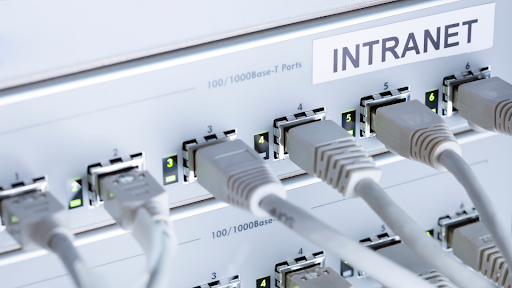An intranet has become an essential tool for businesses. Every organization strives to optimize processes. Maintaining secure employee communication is one of the most important goals. An intranet is a private network used within a company. Modern intranet software is designed to enable teamwork and archiving of information. It acts as a central hub that brings teams together and simplifies workflows, which increases overall productivity.
Companies need to make sure they choose software with the right features to get the most out of an intranet. In this article, we will look at the top features to look for in intranet software and why they are essential for today’s workplace.
1. User-Friendly Interface and Navigation
Why It Matters
The intranet is your inner world and no one except your employees has access to it. Therefore, you should ensure the maximum security of your company’s data. However, if the intranet system is complex or confusing, it may discourage employees from using it. A practical and user-friendly intranet should have an intuitive interface that makes it easy to find information, communicate with colleagues, and complete tasks.
Key Features
✔ Simple and clean dashboard
✔ Customizable navigation menus
✔ Quick access to frequently used tools
✔ Search functionality to locate documents and conversations
A user-friendly intranet ensures employees can adopt and use the platform efficiently without extensive training.
2. Powerful Search Functionality
Why It Matters
Employees spend a significant amount of time searching. There is a lot of data on the Internet – files, documents, employee information, and much more. Proper file organization and a reliable search function help users quickly find the necessary information without wasting time.
Key Features
✔ Smart search with filters and categories
✔ AI-powered recommendations for related content
✔ Ability to search documents, messages, and team discussions
✔ Integration with cloud storage for wider search results
A powerful search function boosts productivity by reducing time spent on locating important documents and information.
3. Seamless Communication Tools
Why It Matters
The ability to work effectively on projects and tasks is one of the main functions of an intranet. Internal communication is important for collaboration and making joint decisions. An intranet should include optimal communication tools that support various types of interactions.
Key Features
✔ Instant messaging and chat channels
✔ Employee directories with contact details
✔ Discussion forums and group threads
✔ Video conferencing and virtual meetings integration
With built-in communication tools, teams can collaborate efficiently, even in remote or hybrid work environments.

4. Social and Engagement Features
Why It Matters
An engaged workforce means higher productivity and compliance with corporate culture. Social features encourage employees to interact. Access to training and stay connected for both social and urgent matters.
Key Features
✔ Employee recognition and reward systems
✔ Company news feeds and announcements
✔ Like, comment, and share options on posts
✔ Polls and surveys for feedback collection
These features create a sense of community and encourage participation within the organization giving the ability to share ideas.
5. Document Management and File Sharing
Why It Matters
An intranet should serve as a secure and centralized document management system. The employees should easily store, access, and share files, get help with support tickets, share announcements, etc. This should not depend on the location or time zone of the organization.
Key Features
✔ Cloud storage integration (Google Drive, OneDrive, Dropbox)
✔ Version control and document history tracking
✔ Secure file-sharing with permissions and access control
✔ Automated workflows for approvals and edits
Efficient document management reduces confusion, eliminates duplication, and ensures teams are always working with the latest version of files.
6. Task Management and Workflow Automation
Why It Matters
A modern intranet should help employees optimize workflows. It includes automation of routine tasks and tracking of project progress. The network works effectively if all employees successfully interact through the corporate portal and perform their tasks.
Key Features
✔ Task assignment and tracking
✔ Automated approval processes for leave requests, reimbursements, etc.
✔ Custom workflows to standardize business processes
✔ Integration with project management tools like Trello and Asana
Workflow automation reduces manual workload, minimizes errors, and speeds up task completion.
7. Mobile Accessibility and Remote Work Support
Why It Matters
You need to provide access to breaking information and important updates to desk-based or frontline employees, and everyone in between right from their pockets. With remote work becoming the norm, employees need mobile-friendly intranet access to stay connected from anywhere 24/7.
Key Features
✔ Responsive design for mobile and tablet access
✔ Dedicated mobile apps for iOS and Android
✔ Secure remote login with multi-factor authentication
✔ Offline access for viewing important documents
A mobile-friendly intranet empowers employees, no matter where or how they work. They can access critical work tools, whether they are in the office, at home, or traveling.
8. Employee Onboarding and Training Modules
Why It Matters
A well-structured onboarding process helps new employees integrate into the company’s space. Modern intranet software should provide employees with resources for training and development. During onboarding, employees must have all the tools and knowledge bases that help to become a part of the company. That allows them to integrate at the cultural and organizational levels and ensure good productivity.
Key Features
✔ Digital onboarding checklists
✔ Training videos, documents, and quizzes
✔ Progress tracking for employee learning
✔ Certification and skills development programs
Onboarding consists of the gradual insertion of the employees within the company reality and the first touch to the business environment affects the employees’ attitudes towards the organization. A built-in learning system ensures employees receive the necessary training and professional development opportunities.

9. Security and Data Protection
Why It Matters
Protecting corporate data in the age of cyber threats and data breaches is critical. The intranet software supports everything: making internal communications possible, storing sensitive data, and helping take after routine business activities. This is the main reason why most organizations turn to using an intranet. A secure network prevents unauthorized access and ensures compliance with data processing regulations.
Key Features
✔ Role-based access control for sensitive information
✔ End-to-end encryption for communication and file sharing
✔ Regular security updates and compliance checks
✔ Multi-factor authentication for secure logins
Internal networks are just as much a target for bad actors as any other public platform. A secure intranet provides peace of mind, ensuring company data is safe from external threats.
10. Integration with Third-Party Tools
Why It Matters
Most businesses use multiple software solutions. Enhancing the intranet with third-party applications can add new functions and improve overall user experience. You may need to add communication platforms, project management tools, or data analytics software. A modern intranet should integrate with third-party applications to improve workflow efficiency.
Key Features
✔ CRM and ERP system integrations
✔ Email and calendar synchronization
✔ Collaboration tools (for example, Slack and Microsoft Teams)
✔ Custom integrations with API access
With seamless integrations, employees can access all their work tools from a single platform, reducing the need to switch between applications.
Conclusion: A Modern Intranet Drives Productivity
Choosing the right intranet software can significantly improve collaboration, efficiency, and employee engagement within an organization. By ensuring that the intranet includes essential features like document management, workflow automation, communication tools, and mobile accessibility, businesses can create a more connected and productive work environment.
As technology evolves, organizations should regularly update their intranet to meet changing workplace needs. Investing in a feature-rich, secure, and user-friendly intranet is key to ensuring long-term success and business growth.













